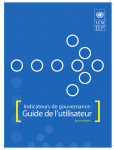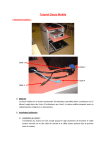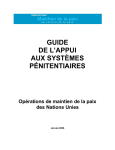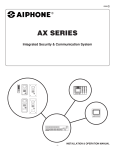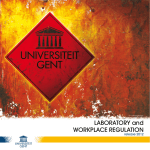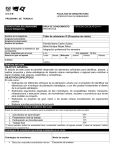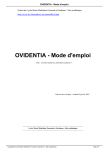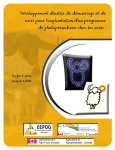Download Best practice in crime analysis
Transcript
BEST PRACTICES IN CRIME ANALYSIS: NEWS & LESSONS FROM LATIN AMERICA Patricio Tudela Poblete Santiago, Chile Septiembre 2013 Author: Patricio Tudela Poblete, Ph.D. in Anthropology (Germany) and Master in Safety Management (Spain). Director of Analysis and Studies of Fundación Paz Ciudadana, Chile. Email: [email protected] and [email protected]. Fundación Paz Ciudadana Valenzuela Castillo 1881 Santiago, Chile 2 CONTENIDO 1. Introduction ........................................................................................................................................... 4 2. The selection of best practices .............................................................................................................. 5 3. Context and challenges for crime analysis ............................................................................................ 6 4. Analysis and crime reduction ................................................................................................................ 9 5. Information management and crime analysis .................................................................................... 13 6. Demystifying crime analysis ................................................................................................................ 14 7. Barriers ................................................................................................................................................ 15 8. Conditions to optimize the analysis of crime in organizations ........................................................... 17 9. What are the impacts ‐ easy challenges or difficult challenges? ........................................................ 19 10. Bibliography ..................................................................................................................................... 22 3 Best Practices in Crime Analysis: News & Lessons from Latin America1 Patricio Tudela Poblete (PH.D./MS.) Fundación Paz Ciudadana ‐ Chile Abstract: This article describes the process of promoting a more effective crime analysis in Latin America and addresses the importance of the institutionalization of criminal analysis units (CAU) for crime prevention and criminal prosecution. Cases are compared and conclusions are drawn regarding the barriers or difficulties and challenges. Crime analysis is a useful tool in the context of security and safety policies, but it must also be upgraded from information management and knowledge management in law enforcement organizations. Keywords: Crime analysis, best practices, Latin America, barriers and challenges, information management and knowledge management in law enforcement agencies. 1. Introduction Learning from what was well done or looking at successes and possible failures or difficulties is a cost effective way of gaining knowledge, preventing anyone from committing the same errors that others have already detected and corrected. That's the original philosophy of this article. Here are presented a set of traits that qualify as obstacles, advantages and challenges associated with crime analysis in 9 countries—using the review and analysis of 37 cases from Latin America. 18 were selected because of their characteristic; they are best practices in crime analysis. Fundación Paz Ciudadana conducted this study with the support from Motorola Solutions Foundation and the International Association of Crime Analysts, IACA). This article analyzes compares and highlights commonalities and explores the achievements and challenges in promoting crime analysis in organizations seeking to improve crime prevention and prosecution. A common denominator to note is not only the collective effort of individuals and institutions, but to go beyond that and consider the variety of initiatives, answers, and efforts to measure and demonstrate through indicators how effective is crime‐analysis, in its distinct forms, and that is not only a necessary activity, but also a key process for establishing policies and strategies to reduce crime and the factors of insecurity in countries of South America. 1 Paper presented at the IACA Training Conference held in Fort Lauderdale on September 13th, 2013. 4 Another major common element of these practices is the close relationship between information management, knowledge management, improving efficiency in prevention and prosecution, crime analysis and the contribution to the generation of better public safety. Associating crime analysis strategies and policies to reduce crime and insecurity is to put on the table a set of challenges institutions are faced with, in order to ensure that this activity renders better results. The examples provided by public and private organizations of various countries in the region, are highlighted here to develop policies for managing information and knowledge. The main challenge is promoting internal and external organizational conditions that allow for better crime analysis. It is recognized, however, that this analysis is performed in the framework of a line of study (apart from the international literature) that aims to identify additional determinants of success or failure in policies to improve skills for analysis in law enforcements agencies. 2. The selection of best practices With the conviction that it is necessary to show the experience of crime analysis in Latin America we have worked since 2010 promoting best practices in crime analysis. Crime analysis must be done well, and people in our countries are also doing interesting and necessary innovations. So the first competition to select “best practices” in crime analysis was organized. Of course, previously it was necessary to review different approaches to response what is a best practice. A best practice is a method or technique that has consistently shown results superior to those achieved with other means, and that is used as a benchmark. In addition, a "best" practice can evolve to become better as improvements are discovered. Documenting and charting procedures and practices is a complicated and time‐consuming process often skipped by organizations. The following approach was drawn up: the choice of the best practices to promote better crime analysis should take into account the following minimal elements: 1. The needs assessment 2. The problem 3. The profile of crime 4. The responsiveness of the organization and professionals by the solutions 5. The empowerment and ownership opportunities with the innovation 6. The actions to promote methods and types of crime analysis (tactical, strategic, investigative, administrative), and 7. The innovation itself With this schema a call for papers was made and from each institution the following information was demanded: a. Title b. Institutional Information c. Description of the elements (problems) that lead to innovating, introducing or implementing technologies and practices of crime analysis in the organization and / or territory 5 d. Description of the conceptual and / or theoretical bases e. General background of the program, project, intervention or format of the crime analysis, objectives (general, specific targets, indicators) f. Description of the information´s management model and the tools used (identifying what or which is the innovation) g. Report about the benefits of the program, project, intervention or new way of analysis h. Description of the problems and obstacles that had to be overcome to implement the innovation i. Identify and explain what processes are critical for better crime analysis (discussion) j. Report of results and evaluation process of the program, project or innovation k. Bibliography Cases from Argentina, Brazil, Colombia, Chile, Mexico, Peru, and Venezuela2 were selected in the context of the first call for to best or promising practices in crime analysis in Lain America. The study was conducted by Fundación Paz Ciudadana (Chile) in collaboration with the International Association of Crime Analysts (IACA) and Motorola Solutions Foundations. 3. Context and challenges for crime analysis Latin America has more than three decades in which police work has been challenged, mainly due to the insecurity experienced by the inhabitants of the main urban areas. The complaint or report rates have risen and the percentages of households and victims are evolving negatively. Moreover, the insecurity (as a psychosocial problem) has settled permanently and extends even to smaller towns, without giving any chance to authorities and institutions responsible for the public safety of citizens. Indeed, the public safety and security of citizens is a social and political necessity, related to criminology and security, not just the existence of crime or crime rates. It also refers to the specific demands of the population and its links in functioning to reduce crime and vulnerability. In this instance, the public safety of citizens is closely related to the mission and tasks of the police and the penal system. All countries have systems and institutions whose shared mission resolve, or at least minimize the causes, manifestations and negative effects of these threats and risks. At the same time, all public institutions (including private) need and use crime analysis procedures and theories. The introduction and improvement of capabilities for crime analysis is part of the modernization of an institution, especially in law enforcement agencies. To achieve this in most countries, the promotion of modernizing reforms in public institutions with the objective to ensure and promote more efficient services (more effective and of better quality) is a key and fundamental (paying more attention in what citizens demands and in their expectations). In this process, the police and other law enforcement agencies are not left out. It is often said that a modern institution is one which will show specific attributes, such as efficiency, effectiveness and quality; in other words, better performance. Crime analysis is important considering this goal. 2 These practices were published in Tudela (2012) and Varela (2013) 6 Generally the lack of performance in these institutions is part of the debate in most countries, because it is a key safety factor (Tudela, 2011b). In this context, the cases presented and selected allow to make three assertions about the relevance of this activity: a) Without crime analysis (in its diverse forms) there is no major effectiveness in the reduction of crime. b) The use of crime analysis in diagnosing and the designing of strategies and policies to reduce crime are keys. c) Crime analysis, that is, the good judgment and performance of an analyst, can help give more validity to the implementation of prevention and prosecution efforts, thus improving the social legitimacy of a public service. From those, it can ascertain that there exists a dual responsibility: to promote and improve these competencies; and, in turn, ensure and demonstrate the products and results of this activity. Therefore, the effectiveness of crime analysis is an essential point; but more importantly, is that this will help improve the quality of life of people. In parallel, several studies show that the attributes of policing are essential to building and maintaining an adequately safe environment and thus, a better quality of life in cities. As such, the quality of police services and, of course, the models and strategies implemented are key, both from a sociopolitical perspective (quality of democracy) and from the point of view of people (safety). For example, focused on the efficiency of the police, a study showed that there are significant structural and contextual correlations: the performance of the police, for example, is greater in countries with low rates of homicide, with an independent judiciary power, and high income, while the size of the police force and population as well as unemployment rates, would be irrelevant to a large extent. It was also noted that there are other important factors, such as perception and how democratic are tactics and strategies of police (Sung, 2006). However, very little has been said about the role of crime analysis and its impact on safety and the legitimacy of the institutions of crime prevention and prosecution. This leads to focusing on the need to better explore various facets associated with a task or fundamental stage for crime reduction: crime analysis. There is no doubt about this. The experience of some countries shows that when the police do not act as expected and as they should, then the climate of safety and dissatisfaction is greater. In our region, according to the Latinobarómetro of the last three years (2009‐2011)3, generally 6 in 10 Latin Americans are dissatisfied with the way the police work, even though this is not the same for all countries. The survey results of the Latin American Public Opinion Program (LAPOP) point in the same direction4. 3 The Latinobarómetro survey consists of a sample of 1,200 cases in Chile and other countries. This is a face to face survey has a margin of error of 2.8% in Chile, while in countries with larger populations, as is the case of Colombia, is estimated at 3.5% to 95% confidence . The sample for Latin America considered 22,695 cases. For online analysis see:http://www.latinobarometro.org/latino/LATAnalize.jsp. (Latinobarómetro is an annual public opinion survey that involves some 19,000 interviews in 18 Latin American countries, representing more than 400 million people. It observes the development of democracies, economies and societies, using indicators of attitude, opinion and behavior.) 4 The Latin American Public Opinion Project (LAPOP) surveys are promoted by the Vanderbilt University since 2004 under the leadership of Dr. M. Seligson. For online analysis see: http://lapop.ccp.ucr.ac.cr/Lapop.html 7 In addition to this, it includes cases where comparatively the police enjoy high levels of public trust and social legitimacy (as Chile and Colombia in relation to Latin America); there also coexists high levels of mistrust. Definitely, high crime victimization rates only explain a part of the levels of mistrust. There are other elements at play. Among specialists and policy makers exists an agreement that it is not possible to improve or maintain the security levels without efficient and effective police, who deliver quality services. This, undoubtedly, poses challenges of various kinds. One of them is to advance the implementation and improvement of crime prevention policies and policing, ensuring good performance. But, add to this also the development of individual skills and institutional capacities for more efficient and effective crime analysis. Thus, among the many reasons to focus on the skills and capabilities for the analysis of crime in law enforcement organizations, the ineffectiveness of law enforcement to follow strategies or standard models is one of the most important. Indeed, the implementation of prevention and control tactics to reduce crime and disorder that were based on the premise that the police presence and deterrence worked well enough have proven to be ineffective. Currently the model is criticized, especially from the moment you install the conviction that it is reactive and that most of the time it is governed by bureaucratic rules, without significant differences with respect to the characteristics of the people, places, times or situations/problems (it only pursues the "application of the law"). In fact, when research shows that the standard model does not have any noticeable effect on crime, disorder or fear of crime, then the need to innovate quickly is installed while looking directly at the relevant role the analysis of crime can play and how it thrives in a favorable internal and external context, if organizational and individual factors are recognized as keys. In the studied cases, the police and criminal prosecution agencies face difficulties or problems to prevent, to investigate crimes and to prosecute offenders effectively. These problems are a common prelude to crime analysis becoming important: the need to innovate and enhance capabilities to be more effective. Another seldom mentioned element (which does not necessarily mean that you're not aware of it), is that the control and enforcement strategies are inefficient, since the institutions show little development in two key areas associated with crime analysis: information and knowledge management. Indeed, as is clear from the statements made by Tilley and Laycock (2010), it is not possible to reduce gaps in control and penal prosecution by trying to improve the efficiency before crime, without the science of crime or the crime analysis. It can be added that this is not possible to achieve this if simultaneously there aren't any innovations or suitable work in equally fundamental areas such as information management and knowledge management within the organization and between institutions. Thus, another common element in most cases is that the tools and methodologies for this purpose have not been sufficiently standardized and implemented (there are no known studies that deal with assessing progress in these dimensions). Today it is knew that the crime reduction strategies represent a significant share of effort in improving the management of information and knowledge, especially in the field of crime analysis (O'Shea & Nicholls 2003a and 2003b). 8 The reduction of crime and insecurity must be addressed and backed analytical processes and practices, as is done in the field of scientific research of social behavior. In this context, of course, theories, assumptions, the nature of the data and its validity are key factors. Just because there has been a lack of will and / or resources or other reasons, certainly working in this direction could also explain the urgency to focus and to review the models and strategies of policing and prosecution, its process indicators and results. The corollary of this situation is so characteristic that, without having to invest additional effort in its demonstration, crime analysis leads us to look at how work the police and prosecution agencies. As highlighted by Licate (2010, p.8) in the case of the Police of Ohio, the institutionalization of a strategic analysis function requires a change in the theoretical assumptions that guide the work of the institutions of security and justice, as well as the adjustment of the organization. As for the supposed theories, the dependence on the standard model of the deterrence theory is supplanted, for example, by the environmental criminology theory, used in work patterns that are more strategic, effective, and modern. This concept is certainly applicable to the reality of Latin America. This can be easily inferred from the cases analyzed. 4. Analysis and crime reduction What is crime analysis used for? Certainly, you can wield various good reasons. But the best will be those that give clues about solutions or recommended courses of action, because of the urgency and importance of the problem of origin (crisis of effectiveness or lack of better policing). No one could deny that the key process in crime reduction is to avoid reproducing the errors that lead to standardized and traditional responses, which, as noted, are often ineffective. In this instance, the analysis of crime is a key activity. Thus, compared to that question, even when the response seems obvious, there are at least two dimensions to consider. The first, and most immediate, is concerned with the utility, while the second with trends and recommendations. First, there are fundamental agreements. For reducing crime there are two basic cognitive needs: explaining and understanding the offense. This is almost obvious, because what you cannot understand or explain (why or how to handle a problem of crime or insecurity) cannot be controlled. It is therefore essential to be aware of the benefits of crime analysis, but also to showing the differences with other tasks is also necessary. The management of data into information and knowledge has a purpose, and should not be an exercise of “illustration”. Hence it should not be confused or not let us believe that since there is had ability and technology to crime mapping and incidents, then there is a useful analysis. That is not so. Crime mapping is only the beginning of a process, from which inferences can be made, but if they are questions that arise on the clarification of some instances, then this will not do. Thus, this only illustrates something of a reality not yet well understood or known. Witnessing the above, for example, in one case shows that solving crimes, even in the case of unknown offenders, is more successful if reasoning tools and features of the criminal analysis itself are used. 9 What is it then? While there are many definitions of analysis, a brief review leads us to value the work done by the International Association of Crime Analysts (IACA), as well as various analysts’ experience reflected in the cases analyzed from Latin America. These concerns converge as Bruce (2010) noted that crime analysis is a systematic process tool for the production of data, information and knowledge "criminologically", designed according to the principles of relevance and timeliness, which starts with the search and identification of correlations between data and data sets as it relates to incidents and criminal acts and patterns of occurrence in a particular place, and serves to guide the efforts of police and improve the response to the demand and requirements of safety and justice in a place and time or a particular situation. Thus, the criminal analysis relates different sources and types of data or information flows, with treatment standards, reasoning, products and results. Accordingly, it should be treated as part of a crime reduction strategy and a process of finding information and solutions “on the ground.” Briefly, the reading of selected Latin American experiences and the review of the international literature, the following steps were identified: 1) The identification and study of incidents / crimes / special problems. 2) The characterization of patterns, trends and criminal issues and safety. 3) The study of factors (causes) associated with these patterns, trends and issues. 4) The dissemination of information so that institutions can develop tactics and strategies to solve or address trends. 5) The study of the results of crime interventions. 6) The consolidation of the experience as a “good practice.” A relevant aspect, which highlights some of the cases analyzed, is that the limits of analysis arise from both the nature of the information available and the quality of the records, as well as the approach used and the solutions sought. Then there is a central point: the key role of the ability to innovate and combine the processing of data available (produced from varied backgrounds in other institutions and stakeholders) and the use of different techniques (qualitative and quantitative data collection) and appropriate software. In the second case, the international recommendations and guidelines highlight some key trends that help understand the benefits of the analysis. The first trend is that the last decade effectively consolidates the belief in the importance of the role of analysis in law enforcement organizations. This has been underlined by the United Nations in various documents, when it comes to crime prevention and the role of the police (ECOSOC 2002/13 and UNODC 2010). A second trend concerns the need and the positive effect of involving various professionals in this task. Indeed, for the United Nations there are different forms of prevention (situational, social, etc.) in which society can and should work5. But there is also how the analysis of crime can and ought to be taken as a practice, work or activity that involves a significant degree of interaction between institutions of 5 Report of the X United Nations Congress on the Prevention of Crime and Treatment of Offenders. A/CONF.187/15. July 2000. No. 104‐106. At: http://www.uncjin.org/Documents/congr10/15s.pdf 10 different natures and purposes, not just those organizations that deal with public safety and criminal prosecution. This is the case of Fundación Paz Ciudadana (Chile), the Committee on Public Safety and Human Rights of the Metropolitan Council, which works together with the Civil Association for Active Peace in Caracas (Venezuela), or the Information System for Security and Convivencia in Medellin (Colombia), which would add “observatories” in other cities and countries in the region. A third trend is the growing conviction that whatever the topic, field or nature, crime reduction policies and actions needed to be based on evidence. Again, according to the United Nations (ECOSOC 2002/13), information management is, or should be, functional to that goal and it emphasizes ‐section on knowledge‐based‐ that crime prevention is not possible access without information strategies, and programs for reducing crime should have a wide base of multidisciplinary knowledge about crime problems, their multiple causes and practices that have proven to be effective and promising (number 11)6. This logic of philosophy of work has become a leader or dominant paradigm, because it ensures or increases the likelihood of success permeating day by day the decision making process in policing and prosecution, especially in the design of policies (Celik, 2010, p.177)7. Accordingly, there is no doubt that police management models and their analytical support are central to reducing crime and maximizing profit: for cost‐effectiveness approach would be optimal. For those analyzed, the experiences of Argentina, Brazil, Colombia, Chile and Venezuela agree that crime analysis does not only seek to observe what is happening or what has happened. In contrast, the analysis seeks to warn and avoid, and takes a proactive pursue: to provide evidence and to reduce crime. Another common element between the practices described is the configuration of a “value chain” that transforms into a virtuous circle if you meet certain attributes and purposes. In other words, the identification and dissemination of information analysis products, related crime patterns, serial crimes, crime trends and safety issues, sought to be prevented still occur. Therefore, the studied cases highlight its utility in targeting resources and efforts for the design and implementation of prevention strategies or for more effective action and suggest (it should be considered) the analysis as a tool for measurement the impact (evaluation) of the actions undertaken. Although the latter is the least developed as of yet. In short, to the question of “why? the reading of selected practices confirm that these methods help reduce crime (effectiveness). However, there emerge two new arguments (related benefits that 6 Also, the rule or recommendation is that government and, where appropriate, civil society should facilitate crime prevention (paragraph 21). In this regard, by way of illustration, here are just some of the recommendations: B) Supporting the generation of useful and practical applications that are scientifically reliable and valid; C) Supporting the organization and synthesis of knowledge and to identify and fill in gaps in the knowledge base, E) Applying this knowledge in replicating successful interventions, developing new initiatives and anticipating new crime problems and prevention opportunities, and F) Establishing data systems to help manage crime prevention more economically, including conducting regular surveys and crime victimization. 7 “Evidence‐based policing” (Welsh, 2006, p.305) could help police decision making in finding appropriate policing strategies for specific problems by the use of scientific evidence. Crime analysts utilizing geographical inferential statistics might play a central role in “predictive policing” (Russo, 2009, 1 as printed), which aims to integrate crime analysis, intelligence–led policing, and crime fighting strategies, to improve police capacity for crime prevention (Celik, 2010, p.177). 11 emphasize innovation and introduce new ways of working in organizations), emphasizing efficiency and accountability: Direct benefit: crime analysis is a fundamental step in planning and implementing the work of the police and prosecution agencies by helping to indicate where and when there is greater need for resources, how to use them and how to monitor the historical evolution of crime rates and crime to intelligently and economically address the causes of crime and not just the effects. Indirect benefit: thanks to the analysis, based on the proper information and knowledge management, planning and subsequent action by law enforcement and prosecution becomes consistent with the criteria of police accountability itself. Thus, the organizations responsible for reducing crime and prosecution become more efficient and effective to society, public opinion and the media, helping to achieve higher levels of public safety. For example, as described by the practices of the Policía de Investigaciones de Chile, Carabineros and prosecutors from National Prosecutor´s Office of Chile, from the analysis of the modus operandi and the known characteristics of the offenders, inferences can be made regarding the operational deployment and targeting of resources. In other words, the analysis can be translated into evidence for: 1. Forecasting the volume of police activities for the coming months and years; 2. Measuring the effectiveness of law enforcement programs and plans implemented and, 3. Distribute the workload in police units following geographic areas, among other criteria. Consequently, if trends continue and thrive in the practices described, it is expected that managers and police chiefs at some point need to review their procedures in an operational analysis or an analysis of an administrative nature. While in most cases it can be inferred that analysts do not seem to use the distribution of the workload, the displacement of crime, the spread of the effects of the focused techniques for crime prevention and evaluation´s program in order to understand the weaknesses and the effectiveness of strategies to reduce crime and disorder. As can be expected, the next step will probably look at the unit responsible for the analysis and the relationship with the organizational environment and, consequently, the evaluation targeted on performance. Indeed, although there is evidence that there is a correlation between crime rates or adoption and integration of units and analysis strategies in organizations, certainly to better assess the analysis in institutions, the context and the organizational environment should be reviewed. From this perspective, organizations can be seen as products of the environment. They adapt and adopt new processes and / or mechanisms to respond to differentiated demand. It is a mistake to assume, as referred Celik (2010, 193), that the crime rate and population size are crucial to the effectiveness of the analysis, especially in regard to the ability to solve problems. Determinants are the contents of the training, and having the ability to use innovative and validated techniques to address crime and crime rates, rather than the size of the population and the institution; 12 i.e. personal attributes rather than the technology available8. In short, the factors that reflect the ability of ownership and empowerment of the organization are the need for effective and timely analysis. These factors lead us to look carefully at the policy leading to the institutionalization of crime analysis in organizations. By the way, there is evidence to confirm that the support of the organization and formalization or institutionalization of the analysis, together with the individual attributes, are more influential than anything else (Celik, 2010, p. 194). 5. Information management and crime analysis What does it consist of? There are various types of analysis (intelligence, investigative, tactical, strategic, administrative and operative). Whatever the type of analysis to be performed, it understand multiple operations and arguments that seek to find relationships between testimonies or statements, evidence or data collected, which are not "obvious" at first sight. We search for associations and causal relationships, based on mapping, statistical techniques (descriptive analysis) and qualitative analysis (content analysis). There is several software that support these processes. This is illustrated in properly selected cases. Thus, the study of the practices leads to the conviction that the crime analysis is a “complex” process and so is using a set of relevant data as evidence, analysts argue, with the hopes of discovering causes, effects, qualities, motives, opportunities, risks, etc., and having them serve as a basis for action. This opinion is consistent with what some call “actionable intelligence” (Ratclife, 2007)9. Indeed, crime analysts can be seen as “knowledge‐based workers”: for they collect, collate and analyze data, and disseminate results. Analysts can give value and meaning to the abstract data and convert it into knowledge for action, which, by the way, is the responsibility of the users of the products of analysis (Celik, 2010, p. 183)10. A fact that deserves attention here is that, while it is a necessary step and the prelude to the analysis, research and preparation of data and information is not, strictly speaking, crime analysis. For that reason, it seems necessary to differentiate and emphasize that the analysis of crime is part of information management, but not equivalent. 8 Indeed, when the analyst does its work it has a purpose associated with a point of view based on assumptions leading to implications and consequences. Uses concepts, ideas and theories to interpret data, facts and uses his experience and that of others in the organization and / or described in detective literature on prevention techniques, in order to answer questions and solve problems. Among the steps or key skills include the ability to identify and generate purposes, ask questions, use information, making inferences, making assumptions, generate implications, critical reasoning and incorporate reflections on their work, identify and recommend solutions or courses of action, skills communication, among others. 9 Ratcliffe (2007) states that it is a process in which data and information are transformed into knowledge and intelligence products. The data is discussed or worked on as observations and measurements on crime, disorder and other challenges facing the police. The information contains the data that is the most relevant and purposeful. The analysis is described as the application of scientific methods to solve the problem. The data and information analysis adds context, meaning and interpretation that produce knowledge. Knowledge products are articles, reports, and books that generate more knowledge, but are not considered “intelligence” until they are linked to a course of action (Licate, 2010, p.2) 10 Law enforcement executives are increasingly recognizing that they are no longer in an information‐ poor world: data and information about the criminal environment and criminal activity abound. The challenge is to corral this wealth of data into knowledge that can enhance decision making, improve strategies to combat crime, and increase crime prevention benefits. In other words, the aim is to convert data and information into actionable intelligence. (Ratcliffe, 2007, p.1). 13 Information management is generally characterized by the following actions: collection and processing for managing and access (database creation); and the records are frequently known as attributes that help describe situations, events or objects in reality that the researcher or analyst seeks, collects or obtains from a file (digital or physical document). Specifically, information management is the set of activities to monitor, store and subsequently retrieve data properly produced, received or retained by the organization doing their tasks or missions. It starts with a good document management and reaches up to the existence of mechanisms to access data in a timely, reliable and validated routine. Consequently, the mere data processing is unsuccessful or irrelevant if does not abide to a particular logic: solving problems, making decisions according to recommend courses of action in order to reduce crime and security problems. This is a common denominator of good practice in crime analysis. Indeed, the core of the analysis methodology is due, first, to a logical process and, secondly, a methodological process. Both are characteristics of the production of scientific knowledge (empirical or cognitive). It consists of a repetitive process, so it follows certain standards which include at a minimum a series of steps. Following the experiences and practices described in the field of law enforcement and prosecution, the logical circuit that optimizes the analysis is as follows: 1) Detection of the problem. 2) Analysis of the situation – cases (with the use of police models). 3) Design a response or hypotheses based on observations of reality and criminological knowledge. 4) Analysis of data describing changes associated with the response made. 5) Validation of the response (impact analysis). On the other hand, the methodological process of analysis, which describes a path to arrive at inferences and valid and reliable knowledge, can be summarized in the following sequence: 1) Data collection and data management. 2) Reading and accessing data. 3) Data analysis. 4) Dissemination of information. 5) Development of strategy. 6) Evaluation. 7) Feedback. 6. Demystifying crime analysis In Latin America rarely is talked about crime analysis. Moreover, there are very few places to discuss, for example, challenges and design solutions, share experiences and recognize good practices. Something similar happens with the opportunities to train people in a systematic and habitual way. 14 Around this activity there are several myths, errors or omissions, which should be cleared for a better understanding and proper implementation in organizations. The review of selected cases is the first attempt to identify best practices in crime analysis and it helps us to identify some points or key aspects for making some assertions to truly understand which the challenges are really: Crime analysis is: 1. A response of the organization(s) that assumes the responsibility for implementing policies and strategies to reduce crime and disorder. Therefore, it can be said that every day obtains new promoters, as crime analysis is validated as a complementary and necessary practice, especially in police and prosecutions agencies and among civil authorities that share equal responsibility in making decisions about crime reduction. 2. It is a work or way of doing that follows a methodology. It uses techniques and procedures for data processing, accompanied by a set of reasoning and inference rules, which assist with triangulation techniques, contrast of sources and types of information readily available in organizations. 3. Not improvised. The analysis is subject to criminal procedures and steps that are based on a set of assumptions and criminological knowledge that aim to help identify crime patterns, solve crime series, and even make short‐term projections. 4. It is not just a product or service, it is also a result, and for that reason, ought to be measured with efficiency and effectiveness, as it focuses on criminal activity (crime, offenders, victims and places) in order to discover and produce sensitive and valuable information that allows for research in order to clarify crimes, apprehend prolific offenders, make an easier efficiently distribution of resources and prevent the occurrence of recurrent crime. 5. Not just a computer issue, but professional skills (human capital). It involves a wide variety of treatment processes and information management, supported by computer software, but the software does make the analyst. The difference is made by the trained staff, not by the technology used. Indeed, one could accomplish this task without computer technology, but it would just be slow and cumbersome. 6. It is a necessary task that cannot be taken on only by the police, but that requires the attendance of “non‐police” professional skills, of professionals in the social sciences and other disciplines, because this is most successful when exists an interdisciplinary collaboration across agencies. 7. The non‐police experts and the police leadership alliances are seen as virtuous strategies to prevent and reduce crime, while information management and analysis are assumed to be opportunities for collaborations rather than threats for organizations. Thus, the crime analysis merits an organizational response and demands crucial professional skills. 7. Barriers 15 But not everything is hunky‐dory. There are also significant barriers to crime analysis. The review of the 11 cases allows us to detect a set of factors or difficulties that consequently limit their impact on the crime reduction: 1. Low quality of the data in the records of the police and prosecution agencies; 2. Poor quality and limited “non‐police” information, i.e. referring to territories or demographic profiles of victims, vulnerable groups (in risk and of risk), and offenders, among others (stale data); 3. Issues of access and flow or transit of data and information within the organization and between institutions; 4. Little knowledge of techniques and limited use of qualitative data sources; 5. Limited use of victimization surveys which complement the police sources for the analysis of crime; 6. The lack of a formal definition and functional roles of the Crime Analysis Unit and analysts within the organization; 7. Low credibility in institutions can diminish the importance of crime analysis, making it commonly as a step or action for marketing or a communications strategy of organizations; 8. Low awareness (willingness) on the need to innovate in crime analysis. If the institution is not the main promoter of the capabilities and uses of crime analysis, it does not thrive significantly, creating an adverse work environment; 9. Lack of formal training and published resources concerning to crime analysis; 10. Ignorance regarding the role and contribution of the analyst. Most times it is sensed, but rarely evidenced in and out of an organization; 11. Belief that the work of the analyst is a "desk job" and ignoring that the role can be a bridge between organizations and the reality for victims or persons working in a territory. 12. Crime analysis does not thrive in an organization if it is not associated with change or innovation intended to transition from a policy to a standard practice; 13. Impact of crime analysis depends on or is directly related to the ability of the organization's headquarters and other institutions to assess and employ the services of the crime analysis units and, 14. Scarce feedback mechanisms affect the tuning required between the user (leadership / decision maker) and the analyst and unit responsible for making or carrying out the various possible types of analysis required in terms of the types of problems to address). 16 8. Conditions to optimize the analysis of crime in organizations How to overcome these obstacles? What is required for crime analysis to be successful and effective in reducing crime? The cases studied give some insight, but not sufficient, which are exposed from a lower to a higher degree of complexity: 1. Identification of routine uses and frequent elaboration of reports; 2. Development of system audits of police records to ensure the validity and quality of data and records; 3. Establishing trust relationships between people, institutions and authorities, as part of a working philosophy of mutual collaboration and co‐production; 4. Introduction and institutionalization of crime analysis (as practice and work unit) on the basis of policy and program development in the organization, and, 5. Develop a plan to promote organizational learning and innovation in crime analysis (introducing new processes and approaches). Certainly, what is mentioned above does not require much explanation. The correlation is simple: crime analysis cannot prosper if there is not a policy (top‐down) on information management and institutional enforcement which is explicitly supported by the appropriate resources. The experiences compared here and the reviews of the experiences of some organizations are extremely useful. Although they do not declare, a second‐order observation of the selected cases would probably confirm that organizations are so complex, that the data and knowledge are fragmented, difficult to locate and share, and, therefore, is redundant and inconsistent if not fully utilized. All cases examined include information as input and highlights various tasks, such as: a) Access to various sources; b) Use of support tools (computer) and c) Quality assurance of registration. Another common element among the analyzed practice cases is that the organizations, both public and private, doomed by the lack of crime analysis, require a data management infrastructure, information and knowledge to configure and enhance the resources and capabilities together. This is a fundamental requirement. Organizing records and data for crime analysis is a key step, known as “information management”. Best practices show that data collection and the generation of information are based on or are aimed at guaranteeing useful criteria in processes that ensure reliability and validity. It is suggested that a checklist be used like the following: 1. What information is needed to answer questions arising from the attempt to solve the problem? 17 2. 3. 4. 5. What data is relevant to the particular problem? What other types of data need to be collected and produced? How do we know this information (data, evidence) is accurate? Is relevant information available to the organization and function of the analyst’s purpose or goal? 6. What information is based on analysis and assessment? 7. Is there bias in the analysis and experience? 8. How is the information and analysis validated (triangulation)? 9. Is there important data and information that we need to consider? 10. What experience (practices and case) support the measures or courses of action recommended? In consequence, the analysis of the practices can infer some characteristics of how to perform this activity in some organizations: a) Information management and crime analysis in organizations do not refer only to documents or databases, but also in organizational routines, processes and standards of behavior. b) The more rigid and centralized organizations with less dynamic structures, have more problems to share and integrate their processes of information and knowledge. c) Coordination problems are significantly correlated with the size of the organization. d) Teams in small organizations tend to work together, while in large organizations do so dispersed. e) Working together facilitates communication, coordination and knowledge sharing. f) The problems of collaborations are associated with both physical and geographical distances, and to differences in culture, language and interests, but basic mental distances reflect how we see and act as an organization. g) While collaboration is necessary, sharing information and knowledge is often problematic, requiring a policy to facilitate it. It is interesting to observe that in several cases studied, coincidentally with the literature reviewed11 extra‐institutional variables or situations or circumstances, organizational factors and individual attributes are highlighted. Accordingly, there are (at least) two dimensional determinants in this field: the first is related to the internal/external dynamic in which the analysis is conducted (the point of reference is the analyst versus the organization, and the organization in relation to other organizations); and the second relation is the internal purposes (the analyst in the organization) and how it is transformed into knowledge to support an efficient and effective policy for reducing crime. The institutions that seek to improve the analysis can be facilitators or, paradoxically, present obstacles. What obstacles arise? An analysis of the experiences of the region shed some light. The support of the organization is necessary, but sometimes it is not strong enough to show how this contributes to the achievement of organizational goals. While internal and external users value the analysis of crime, for a successful analysis an enabling environment is required. 11 The analysis of these features is consistent with that described in other parts, especially in deeper studies conducted in the last decade (O'Shea and Nicholls, 2003a and 2003b; Taylor, Kowalyk & Boba, 2007; Licate, 2010; Celik, 2010). 18 The lack of consolidation of crime analysis in the organization is related to the acceptance, sometimes preliminary, of its usefulness and demonstrates only partial benefits, and further relates to the existence of specialized units to support police work and prosecution. The feedback between the analysts and the users is necessary too. It is known that organizational culture often undervalues whoever works “behind a desk” or it is believed that the analyst does not belong to “the operative world.” This is true in Latin America and in countries where for decades crime analysis is a developed practice too (Taylor, Kowalyk and Boba 2007, 162). The cases shows that when there are good communication practices among police on the street and members of crime analysis units, the use of the analysis in the organization is improved. In this context it is important to consider what Celik states (2010, 184): When an analyst believes that its products are highly beneficial for end users, they are motivated to use various types of analysis techniques, seeking various troubleshooting tools and employ a wider range of data types in crime analysis. Thus, the internal strategy and the willingness to adopt innovative techniques in crime prevention and prosecution in association with the implementation of appropriate technology can be significant and predictive factors as demonstrated by Celik (2010). 9. What are the impacts ‐ easy challenges or difficult challenges? As the cases examined show, the analysis not only requires data and technology, but fundamentally trained personnel and a work environment that optimizes the productivity of analysts. Organizations that have established crime analysis units have used special staff to perform specific tasks and allocated adequate resources for better information management. However, even when crime analysis has been established as a fundamental activity, there is still a gap for the analysis to gain legitimacy as a profession in organizations and, moreover, as an indispensable and essential organizational capacity that is inherent to crime reduction and efficient criminal prosecution. In this context it should be noted that programs and mechanisms that give sustainability to the induction and improvement of the skills and organizational capacities of crime analysis are not mentioned. This is a weakness that must be addressed and overcome. How is the experience of analysis in the organization capitalized? Indeed, as it has been documented elsewhere, here lies a major difficulty, since in most cases the process of institutionalization and validation of these cases have clashed with elements related to organizational culture, the weakness of certain determinants for success, and lack of the policies focused in the promotion of crime analysis. In fact, it is no longer talked about information management. It is not mentioned the existence of mechanisms and processes aimed at knowledge management and the accumulation of experience (systematization of best practices or promising practices in crime analysis). 19 In practice, knowledge can be understood as a “set of images, beliefs, meanings and experiences that enhance the ability of understanding and that determine the ability to execute tasks, solve problems, and make decisions” (Prieto 2003, p. 23, quoted by Badiola, 2010). The notion of knowledge in the organizational context includes aspects of information available to individuals and organizations, which are relevant to reach an understanding of their decision setting and to choose and implement the most appropriate courses of action in that particular context and assimilate the results that cause such actions (Badiola 2010, p. 22). Paraphrasing Badiola (2010, p. 32), knowledge management is linked to organizational learning, that is, creating the ability to acquire and manage information and with development encourage potential for change in an institution. The conversion of tacit to explicit knowledge forms the so‐called “spiral of organizational knowledge creation”, which aims to create conditions and incentives so that the knowledge of individuals is incorporated into the organizational structure and can be used by other analysts, it is a relevant factor in this case. However, very little of this occurs in crime analysis. The instituting of knowledge is the core of organizational learning; specifically, the organization that learns is that which is continually evolving, transforming its flow of information in a stock of knowledge that is disseminated to other areas or units, allowing it to produce superb result and services. Thus, information management is organizational learning, adaptation, improvement of quality of services, and the strengthening human capital. Therefore, the induction of crime analysis practices will lead us to address the learning of the organization, both the change/adaptation of organizational behavior, and the creation of a knowledge base that supports it. In short, organizational learning is a dynamic process that occurs at different levels of the organization, driven by the interactions with external and internal stimuli, and is aimed at obtaining new knowledge relevant in part to those individuals and groups that comprise it who generate and develop skills to improve the performance and results and who contribute to the acquisition of competitive advantages that have an effect on performance. In the case of an agency focused on prevention or criminal prosecution, information management is related to the processes by which the institution acquires, produces, stores, shares, and uses knowledge, ideas and experiences to improve the fulfillment of the mission of the organization. The information management in crime analysis implies specifically to generate, search, store, disseminate, use and share information within the organization. For this several conditions must be there: a) Mechanisms and instances to identify knowledge needs, more than just information and data; b) Establish mechanisms needed to acquire, store, share and transfer in all directions, the knowledge that resides in each division, and headquarter, especially in a crime analysis unit; c) Have the ability to recover the experience and know‐how the organization and the analysts have gained over the years; d) Strengthening and improving flows of knowledge in all existing processes to increase efficiency and effectiveness in the daily work of the organization; e) Be able to recognize experts and expertise and value them (incentives); f) Distribute knowledge according to the needs and preferences; 20 g) Provide, with the explicit knowledge, a best practice in the fight against crime. It is said that a better management of knowledge is related to the organizational culture and human factors by 80%, and that only 20% is related to technology. According to this, the conditions to give processes sustainability and capitalize on crime analysis in organizations will depend more on systematic work than the quality of knowledge, productivity and capital treatment of the organization. In other words, it will depend on doing whatever it takes to get the most of the resources, analytical skills and knowledge in the organization. None of this will happen if you do not have policies and strategies to sustain the organizational and functional purposes. According to the above and considering the factors that have hindered crime analysis practices in the cases considered in this study (allowing us to extend and refine the list of factors discussed in the Second International Workshop on Smart Strategies to Reduce Crime, organized by the International Association of Crime Analysts and Fundación Paz Ciudadana (Tudela 2011a), the construction of an environment for crime analysis involves: 1) Commitment of the governing body to promoting crime analysis. 2) A responsible structure. 3) Optimal equipment. 4) A flow of information flow ‐ clear communication. 5) Trained staff. 6) A demanding organization guided by the conviction that crime analysis serves as a basis for operational responses and the services it provides the organization in crime prevention and criminal prosecution. 7) The philosophy that police interventions or actions must be based on evidence. 8) Administrative processes and organizational flexibility. 9) A space for collective learning. 10) Mechanisms for the study and identification of lessons learned that should serve as the basis for creative and innovative intervention. Finally, the importance of standardization and institutionalization of crime analysis in the organization can be measured through indicators of activity and impact associated with the following variables or factors: a) The mission statement and job description, or standard operating procedure. b) Use of databases and information to analyze problems. c) The use of proven technologies, such as the SARA model, for analyzing and recommending courses of action. d) The identification and access to sources of police experience (evidence based). e) The process of selection for staff that will work as analysts. f) The process of training and specialization. g) The feedback mechanisms. To conclude, it should be emphasized that information and knowledge are constant challenges in organizations that deal with the crime prevention and prosecution. But, in the same way, it is also important to accept and recognize that crime reduction strategies and criminal prosecution demand 21 information management and crime analysis as much as knowledge management, as they are key issues for more efficient, timely and effective action. The 18 selected cases suggest that the most significant challenge is that organizations can overcome the problems of translation, i.e. databases, intervention experiences, and validation of results with the accumulated knowledge (organizational capital), because the gap between information search, analysis, intervention strategy and evaluation are not reduced still (challenges). 10. Bibliography Badiola, I. (2010). Gestión del conocimiento en organizaciones policiales: el caso de la Policía de Investigaciones de Chile. Trabajo Final del Máster en Gestión y Planificación Estratégica, Universidad Autónoma de Barcelona, ASEPOL‐PDI, Santiago. 235 p. Bruce, C. (2010). Fundamentos del análisis delictual. En: Análisis delictual: enfoque y metodología para la reducción del delito. Tudela, P. (Ed.). Santiago, Chile: Fundación Paz Ciudadana, IACA. Celik, I. (2010). Environmental, organizational and individual determinants of crime analysts’ problem‐ solving capacities: a contingency approach. Ph.D. Dissertation, University of Texas at Dallas. Graduate Program in Public Affairs. Licate, D. (2010). Innovations and organizational change in Ohio Police Department. Ph. D. Dissertation, Kent State University. Retrieved from: http://etd.ohiolink.edu/send‐ pdf.cgi/Licate%20David%20A.pdf?kent1289880822 National Research Council of the National Academies (2004). Fairness and effectiveness in policing: The evidence. (pp.217‐251). Washington, D.C: National Academies. Organización de Naciones Unidas. (2002). Medidas para promover la prevención eficaz del delito (ECOSOC RES. 2002/13). En: Oficina de las Naciones Unidas contra la Droga y el Delito (2007). Recopilación de reglas y normas de las Naciones Unidas en la esfera de la prevención del delito y la justicia penal en Viena. Nueva York: ONUDD Oficina de las Naciones Unidas contra la Droga y el Delito. (2010). Sistemas policiales de información e inteligencia. Manual de instrucciones para la evaluación de la justicia penal. Nueva York: ONUDD. Retrieved from: http://www.unodc.org/documents/justice‐and‐prison‐ reform/crimeprevention/Police_Information_and_Intelligence_Systems_Spanish.pdf O’Shea, T. y Nicholls, K. (2003a). Crime analysis in America: Finding and Recommendations. Washington, D.C.: Office of Community Oriented Policing services, U.S. Department of Justice. Retrieved from: http://www.cops.usdoj.gov/files/RIC/Publications/e03031891_web.pdf O’Shea, T. y Nicholls, K. (2003b). Police Crime Analysis: a Survey of U.S. Police Departments with 100 or more Sworn Personnel. Police Practice and Research 4 (3), 233‐250. 22 Ratcliffe, J. (2007). Integrated Intelligence and Crime Analysis: Enhanced Information Management for Law Enforcement Leaders. Washington, D.C.: Police Foundation. Recuperado de: http://www.cops.usdoj.gov/Publications/integratedanalysis.txt Russo, T. (2009). Predictive Policing: A National Discussion. Retrieved from: http://blogs.usdoj.gov/blog/archives/385 Sung, Hung‐En (2006). Structural determinants of police effectiveness in market democracies. Police Quarterly 9 (1), 3–19 Taylor, B.; Kowalyk, A. & Boba, R. (2007). The integration of crime analysis into law enforcement agencies: an exploratory study into the perceptions of crime analysts. Police Quarterly 10 (2), 154‐169. Tilley, R. & Laycock, G. (2010). De la prevención del delito a la ciencia del delito. En: Análisis delictual: enfoque y metodología para la reducción del delito. Tudela, P. (Ed.). Santiago, Chile, Fundación Paz Ciudadana, IACA. http://www.pazciudadana.cl/docs/pub_20101129130944.pdf Tudela, P. (2011a). Desafíos de la gestión de la información y el análisis delictual en el marco de las políticas de seguridad: ¿qué debemos hacer? Intervención en el II Módulo del Segundo Seminario Internacional sobre Estrategias Inteligentes para la Reducción del Delito. Organizado por la International Association of Crime Analysts (IACA) y Fundación Paz Ciudadana. Santiago, 5 Abril de 2012. Retrieved from: http://www.pazciudadana.cl/docs/ext_20110405121532.pdf Tudela, P. (2011b). La medición del desempeño policial en Chile: consideraciones sobre la calidad de los servicios y el trato a víctimas y denunciantes. Conceptos (Fundación Paz Ciudadana), 22, 1‐34. Retrieved from: http://www.pazciudadana.cl/docs/pub_20110902154443.pdf Tudela, P. (2012). Buenas prácticas para el análisis delictual en América Latina 2012. Santiago, Chile: Fundación Paz Ciudadana, Morotola Solutions Foundation, International Association of Crime Analysts. Santiago. Retrieved from: http://www.pazciudadana.cl/wp‐content/uploads/2013/07/2012‐06‐ 20_Buenas‐pr%C3%83%C2%A1cticas‐para‐el‐an%C3%83%C2%A1lisis‐delictual‐en‐ Am%C3%83%C2%A9rica‐Latina.pdf Varela, F. (2013). Buenas prácticas para el análisis delictual en América Latina 2013. Santiago, Chile: Fundación Paz Ciudadana, Morotola Solutions Foundation. International Association of Crime Analysts and Hans Seidel Stiftung. Retrieved from: http://www.pazciudadana.cl/wp‐ content/uploads/2013/06/buenas‐practicas_reducido_web.pdf 23



























